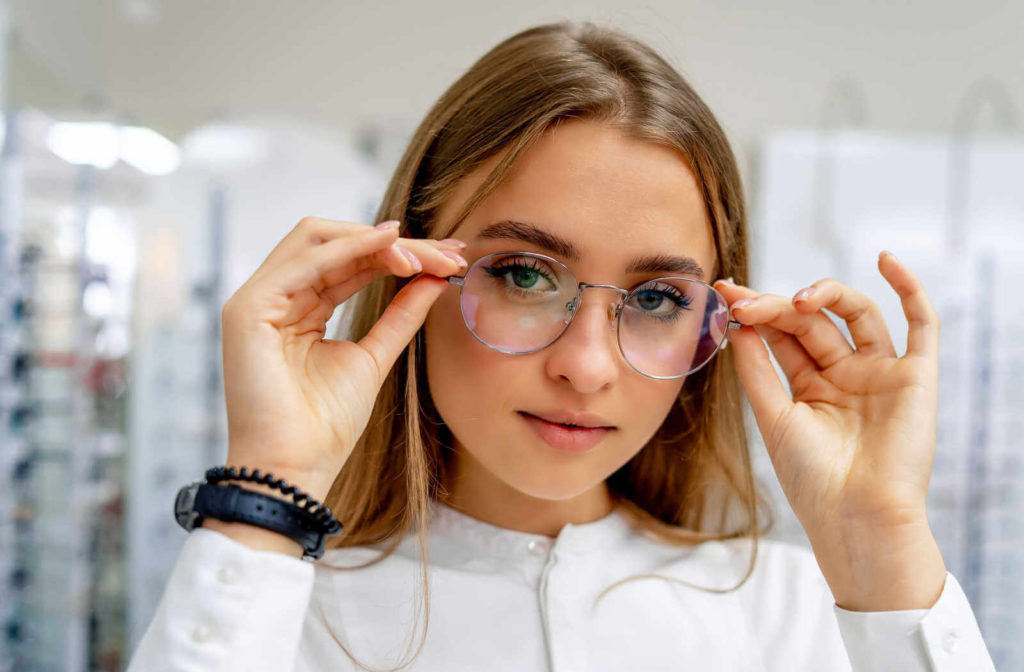Visiting your eye doctor to maintain healthy eyesight and vision is like visiting your physician for a healthy body. Comprehensive eye exams for adults and children can help detect eye conditions early and determine treatment based on visual needs.
Astigmatism and myopia are common refractive errors with similar symptoms, including blurred vision. But they’re 2 different eye conditions. Not to be confused, we discuss their causes, symptoms, and treatment options.
Refractive Errors
Refractive errors are vision problems that make it difficult to see clearly.
When light enters the eye, the cornea and the lens work together to focus light on the retina. If an eye is too long or too short, or the cornea is too steep or too flat, light isn’t bent properly and won’t land on the retina, making images appear blurry.
Refractive errors include:
- Myopia or nearsightedness
- Hyperopia or farsightedness
- Astigmatism
- Presbyopia
Astigmatism
Astigmatism is a defect in the cornea’s curvature, where it has a football or egg shape instead of a spherical one. When light enters the eye, it focuses on multiple points on the retina, which causes objects at any distance, near or far, to appear blurry. You can have astigmatism as well as nearsightedness or farsightedness.
Causes of Astigmatism
The exact cause of astigmatism is unknown, but genetics plays a role. Astigmatism is often present at birth but can also develop later due to:
- An eye injury
- Eye surgery
- In some cases, keratoconus—thinning & bulging of the cornea
Symptoms of Astigmatism
There is an overlap of symptoms in astigmatism and myopia. Here is a list of astigmatism symptoms:
- Blurry vision, near or far
- Difficulty seeing at night
- Eye irritation
- Eyestrain
- Headaches
- Squinting to try and focus
- Visual weakness
- Two-fold or double vision
- Redness
Treatment of Astigmatism
Astigmatism is easily corrected with glasses, which compensate for the irregular shape of the eye to provide clear vision. Contact lenses designed to correct astigmatism are also available. Orthokeratology specialty contacts can also help gently reshape the cornea overnight to provide clear vision without eyewear during the day.
Refractive surgery is a more long-term treatment for those who can’t wear contact lenses. It involves using a laser to reshape the cornea.

Myopia
Myopia or nearsightedness causes objects nearby to be clear while distant objects appear blurry. Myopia usually becomes noticeable during early childhood and levels off in the teens but can worsen with age.
Myopia occurs when the eye grows too long or the cornea becomes too steep, causing light that enters the eye to focus in front of the retina instead of on it. It usually develops during childhood, when growth is rapid.
There’s no way to reverse myopia, but the goal is myopia control to slow its progression in children and prevent high myopia and its associated eye health risks.
Causes of Myopia
If one or both parents have myopia, there’s an increased risk of developing this condition. Apart from genetics, environmental factors can also play a role. Long hours of near-vision or near-focused work, such as reading or screen time, can increase a child’s risk of myopia.
Ultimately, the exact cause of myopia is complicated.
Symptoms of Myopia
Common symptoms of myopia include:
- Blurry distance vision
- Eye strain
- Headaches
- Squinting to focus on objects far away
- Difficulty seeing the white or blackboard at school
- Sitting close to the television to see
- Holding books very close to the eyes
Treatment of Myopia
Like astigmatism, myopia is easily corrected with eyeglasses, contact lenses, or refractive surgery, which helps focus light on the retina and improve distance vision. Nearsighted people often need to change their prescriptions frequently.
Myopia development can be controlled and slowed in growing eyes, and methods of slowing its progression in children are safe and effective.
Differences Between Myopia & Astigmatism
Here is a quick recap of the differences between myopia and astigmatism:
- In myopia, the eye is too long or the cornea is too steep. In astigmatism, the cornea is abnormally curved.
- Myopia causes light to focus in front of the retina. Astigmatism causes light to focus on multiple points on the retina.
- Myopia usually develops in early childhood and can stabilize later. Astigmatism can develop at any age.
- Myopia makes distant objects appear blurry. Astigmatism makes objects at any distance appear blurry.
Vision Care at Metro Eyecare
Myopia and astigmatism are not the same error. Despite sharing some symptoms, your eye doctor can diagnose your condition and provide individualized solutions to help you achieve crisp, clear vision.
If you’re unsure about your symptoms, book an appointment with Metro Eyecare. Our staff can help determine why your vision is blurry.


